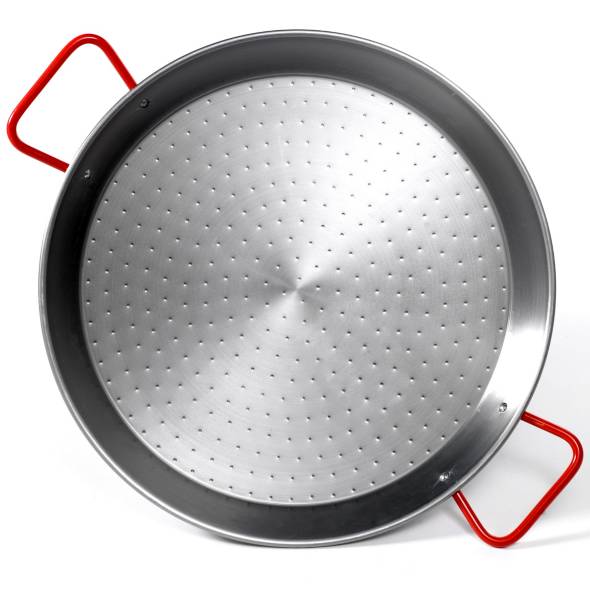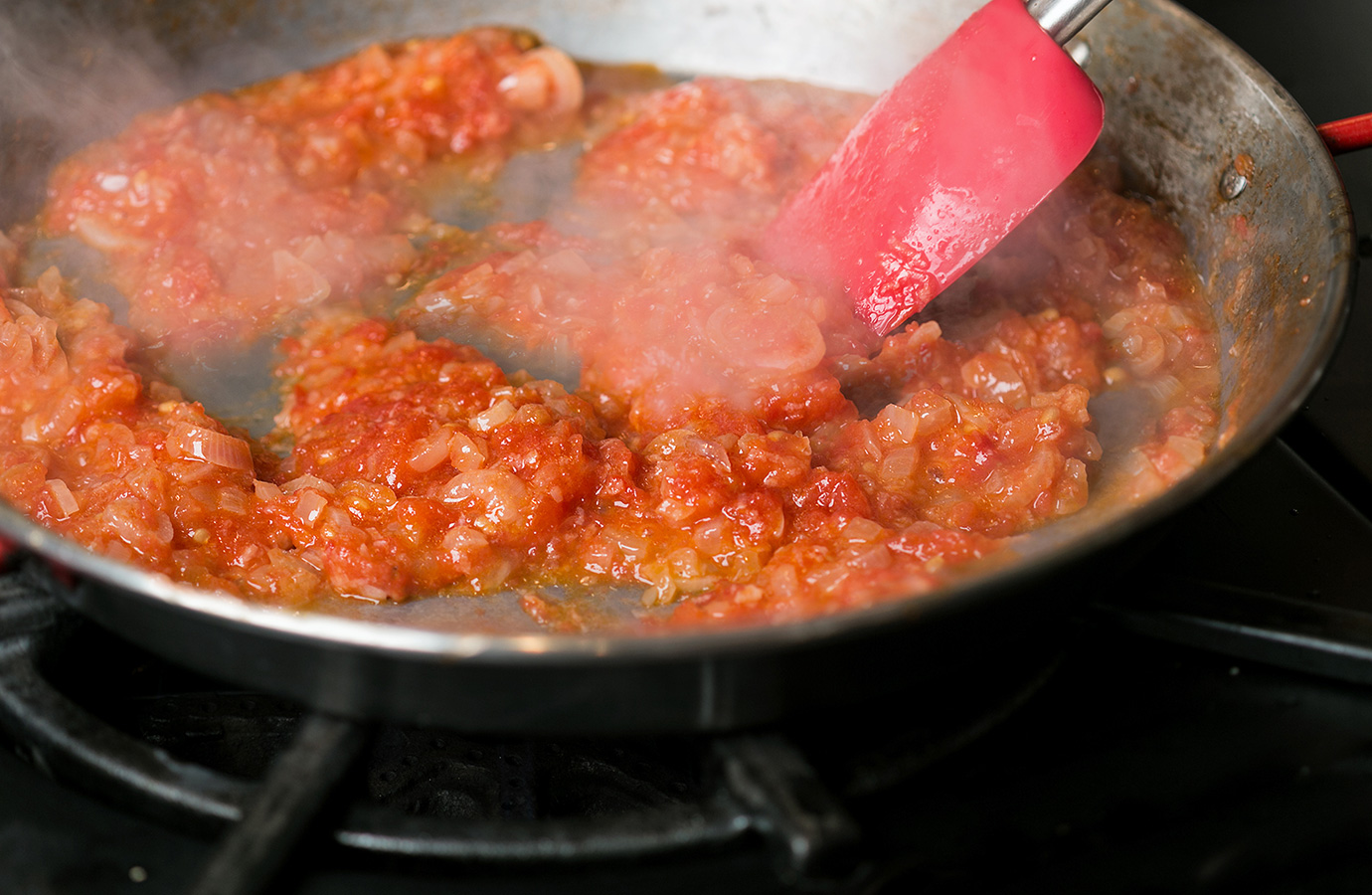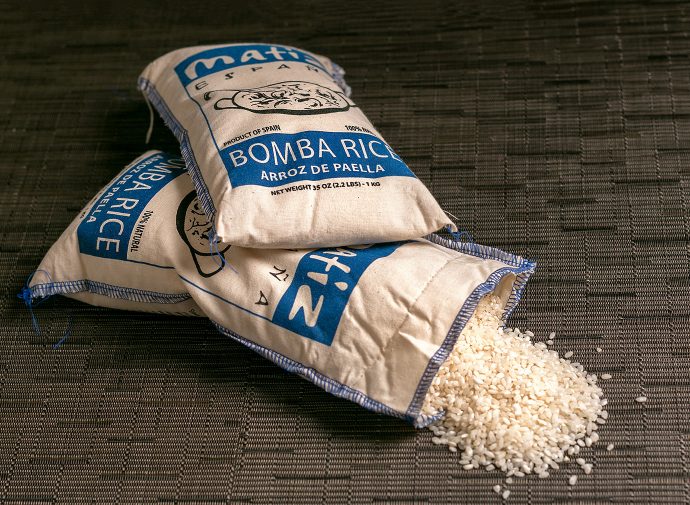Paella can mean several things. It’s the name of a rice-based dish with poultry, seafood or game, depending on the region in Spain where it is prepared. It’s also the name of the pan in which that rice is cooked. And paella is also an activity—it’s what you do on a Sunday. If you’re lucky, the whole family will be gathered around an enormous paella pan simmering over an open fire.
Most American versions of paella are made with long grain rice. Wrong! The other ingredients, the expensive ones, like seafood, poultry and sausage, are cooked separately and then piled on top of the rice. The only authentic thing about these paella is the pan in which the dish is served.
My first opportunity to taste the real thing was while visiting the vineyards of Jose Puig outside of Barcelona. It was on a Sunday. To celebrate the conclusion of the grape harvest, Puig prepared a true Paella Valenciana, with local ingredients…chicken, rabbit, green beans, artichokes, and a sofrito of tomato, garlic, smoked paprika and olive oil. The paella was cooked outdoors in an enormous four-handled pan over a fire fueled with vine branches, then served to the men and women, and their families, who had participated in the gathering of the grapes.
The Rice
All Spanish cooks agree that rice is the star of paella. The other key to a great paella is a deeply flavored broth. The rest of the ingredients are garnish. Paella prepared in the States tend to showcase the expensive components, piled on top, while the goal in Spain is that the individual taste of each ingredient can be enjoyed while the flavor of the whole dish is coherent.
Measures of rice and liquid can vary, depending on the variety of rice, your heat source and pan size, all of which affect the rate of the broth’s evaporation. Choose a variety of rice that is prized for its ability to absorb flavorful stock. Bomba rice, grown in the Calasparra region of Murcia, is favored by chefs for its capacity to absorb liquids and expand. It can be difficult to find. Many chefs swear by arborio and vialone nano, commonly used for making risotto. Unlike basmati rice, which expands lengthwise, bomba and risotto rice varieties expands width-wise, like an accordion. The basic ratio, using traditional short to medium grain rice, is 1 part rice to 2 parts broth, 1:2. If you are using bomba rice, with its amazing capacity to expand, the ratio would be more like 1:3.
As the paella simmers away, stay flexible. You may always add more broth if the rice seems too dry or raw, or quickly cook off some extra liquid with a high flame while you rotate your pan for even cooking. After a couple of paella, you will get comfortable with your timing, your pan and your stove.
The Pan

Cook your paella in a traditional pan from Valencia, used by Spaniards for centuries. It’s made of polished carbon steel pan, fitted with two handles. It’s available by mail order for around $25.00 from La Tienda. It’s worthwhile supporting this website, which is a great source for all things related to Spanish food, including ingredients, equipment and tableware. However, it’s also available from the ubiquitous Amazon for the same price. If you don’t have a paella pan, choose a skillet with a wide bottom and low sides.
A 15- or 16-inch pan makes enough paella for 4 to 6 people, and I think this is the most practical size. You can use it on top of the stove, in the oven, or on an outdoor grill. La Tienda suggests washing the pan with soap and water, drying it thoroughly, brushing it with olive oil and then baking it in a 350ºF oven for several hours before the first use. After each use, treat the pan as you would a cast iron pan: wash it by hand, then season it with a light film of oil to retard rusting.
Building The Base
Good paella starts with a sofrito, a slow cooked mixture of garlic, onion, and tomato, often with the addition of paprika and fresh herbs. Different regions prepare different versions of sofrito. I favor the Catalan style, with its jammy tomatoes, golden onion and garlic.

Socarret
The caramelized flavorful crust of rice that forms on the bottom of the pan is called socarret. This marvelously textured tasty delight is revered by diners and often served separately by the host to important guests.
The creation of the socarret requires familiarity with your heat source and your pan. The traditional pan, with its wide, shallow shape and relatively thin bottom, allows the greatest amount of rice to come in contact with the bottom of the pan, where flavors are concentrated. To create the crust, let the paella rest, covered and off the heat, for 10 or 15 minutes. Then, right before serving, return the paella to the stovetop over high heat. Use all your senses to hear the sizzle and crackling noise and smell the toasting rice, telling you the right moment to pull the pan. If there is any acrid or burning smell, you’ve waited too long.
Basic Technique
There’s truth to the saying that there are as many paella recipes as there are cooks, but there are some basic principles. Preparation starts with the sofrito. Then, the rice is added and stirred until the grains are translucent, coated in the oil and pan seasonings. Next, boiling broth is added, and everything bubbles away until all the liquid has evaporated and each fluffy grain has absorbed the flavor of the other ingredients. When the rice starts to peak through the broth, the surface of the paella is garnished with the type of ingredients used to create the flavorful stock, and the pan goes into a 350ºF oven for 10 to 15 minutes. Finally, it rests out of the oven, covered (it’s tastiest after it has cooled down) for at least another 15 minutes. At this point, it can go back on the heat to form the socarret before being served directly from the pan.
Traditional Spanish paella is made with local ingredients, with differences in style dictated by what is available in a particular region. If you follow this concept, it is a dish that can be a part of everyday life, not just special occasion food. It’s a great way to use up leftover ingredients…bits of chicken, meat or seafood… and completed with ingredients that are regularly stocked in a pantry—garlic, onion, tomato, rice, paprika and maybe a pinch of saffron.

